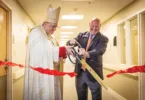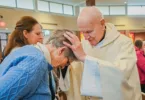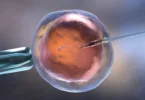
Sonia Warshawski, a Holocaust survivor and subject of the documentary “Big Sonia,” speaks to a packed Curé of Ars Church in Leawood Jan. 28, just one day after Holocaust Memorial Day. LEAVEN PHOTO BY JOE MCSORLEY
by Moira Cullings
moira.cullings@theleaven.org
LEAWOOD — Sonia Warshawski survived three concentration camps, a death march and a bullet to the chest.
But the 92-year-old Holocaust survivor and subject of a documentary film called “Big Sonia” had a surprising message for those gathered at Curé of Ars Church in Leawood on Jan. 28, just one day after Holocaust Memorial Day.
“I always start with encouraging the young people to read history,” said Sonia.
And then she adds a simple request.
“If any hate is in your heart,” she asks, “please take out the hate.”
Sonia, who was accompanied by her daughter Regina, is the only Holocaust survivor in the Kansas City area still out speaking about her experience. She lives in Kansas City, Kansas.
Underneath the floorboards
Sonia grew up in a Polish town called Miedzyrzec with her parents, brother and sister.
Holding up an old photograph of Sonia with her immediate and extended family, Regina pointed out that everyone in the photo was murdered by the Nazis but two — Sonia and her sister.
“The statistic in Poland alone is nine out of 10 Jews were murdered in the Holocaust,” said Regina. “Throughout Europe, two out of every three Jews were murdered.”
Once Nazis took over their town, Sonia’s family lived in the Miedzyrzec ghetto from 1941 to 1943, said Regina.
The Nazis performed six roundups during that time. Each time, the Jews “rounded up” were taken to the train that would transport them to a concentration — or death — camp.
Sonia’s grandfather kept the family safe through four roundups by hiding them beneath a bedroom’s floorboards.
The fifth time, she said, was different.
“When they came with German shepherds, they sniffed us out of the hiding,” said Sonia.
Surviving the journey
A few lucky Jews, Sonia’s father and sister included, managed to break free from their captors in the melee of the roundup.
But Sonia and her mother had no such opportunity and were loaded into a cattle car bound for the Treblinka death camp.
Into a cattle car meant for 35 cows were crammed over 100 people.
“They put us like sardines,” said Sonia. “You couldn’t move. You couldn’t sit.”
Suddenly, the train stopped.
“They couldn’t kill the people in Treblinka fast enough,” said Sonia. “So our train was rerailed to Majdanek [concentration camp].”
The cattle cars could be no less deadly.
Sonia recalled the summer heat during one journey, when many were dying of thirst.
“I was standing on dead bodies to reach the little window,” said Sonia.
She had a bit of money her mother had given her and, during a stop, was able to stick her hand through a small window draped with wiring to give the cash to a worker in exchange for water.
“When I managed to get this little canteen, I managed to take a sip of water,” said Sonia.
“Then I tried to give it to my mom. Today, I don’t remember if she managed [to drink it],” she said. “People were just bewildered.”
When Sonia and her mom made it to Majdanek, a camp on the outskirts of the Polish town of Lublin, they could see houses close by the camp.
“They all knew,” said Sonia.
“They had to smell the smell and the smoke,” she added.
The camp had one crematorium and one gas chamber. And during their first “selection,” Sonia and her mom were both sent to the right.
Being sent to the left would have meant their immediate death.
“Majdanek was a horrible, big camp,” said Sonia, one she said she wouldn’t have survived without her mom.
“There is not in this world a bigger love than your mom,” she said. “I know the fathers love you, too, but there is a different love. We are a part of our mothers.”
Those who lived in Majdanek had to get up early to fetch water from the one well available at the camp. Sonia recalled her mom waiting in the line and getting the water for her.
“She would say softly, ‘Please stay a little longer, and I will do it for you,’” she recalled.
‘Never forget!’
One of Sonia’s most vivid memories from her time at Majdanek was being called to gather in the square.
“I noticed right away that somebody was going to be hanged,” said Sonia. “I’ll never forget in my entire life the two little girls that probably were my age at the time.
“They tried to escape and they got caught.”
Two SS women stood on either side of the ropes that would be used to hang the girls.
“The little girls were carrying little stools to be able to catch the rope,” said Sonia. “When the little stools were taken away, their last shriek before they died on those ropes was: ‘Never forget! Take revenge!’
“Still today I hear those voices from the two little girls.”
The young girls’ bodies hung for several days before they were finally taken to the crematorium.
But the worst was yet to come.
Doctor Josef Mengele, famous for his experimentation on twins at Auschwitz, performed multiple “selections” at Majdanek as well.
And their luck — if it could be called that — had run out.
At one of these “selections,” Mengele sent her mother to the left — and Sonia to the right.
Even knowing what she knew about being sent left, said Sonia, “In that moment, I wanted to go with my mom.”
But an SS woman shoved Sonia to the right, and moments later, she caught a glimpse of her mom through a peephole.
“I saw her walking with another lady from my hometown,” she said. “They were holding each other.
“This is the last time I saw my mom.”
Death march
The next day, Sonia was sent to Auschwitz-Birkenau, a camp able to house 100,000 prisoners at a time.
“By the end of the war,” said Regina, “they had murdered approximately 1.5 million people [there].”
The camp had five gas chambers, and it took about 30 minutes to gas each group.
When Mengele tore twins from their mothers’ care, many of those women threw themselves onto the electrified fence, said Sonia, which killed them instantly.
“Every morning, we had suicides,” said Sonia.
But Sonia was determined to survive — and would run any risk to do so.
When she realized her bony figure would never allow her to pass Mengele’s next “selection,” she hid from two of them.
The first time, she was waiting with the others inside a selection building when she saw two rooms filled with bundles of clothing.
“When I saw the SS woman and SS man turn their heads, I rushed in under those bundles,” she said.
Other girls noticed her running and followed her, but were quickly discovered.
Sonia was the only one who wasn’t, but the others didn’t give her away.
“After the ‘selection’ was over, it was quiet,” she recalled. “I put on my clothes and went back to my barrack.”
Sonia spent about a year and a half at the camp. In January 1945, as it was becoming clearer that Germany was losing the war and surrender was a possibility, she and her fellow prisoners were marched out of Auschwitz for the last time.
Liberation day
Sonia ended up on a train that took her to Dachau, and then was sent to Bergen-Belsen, where she lived for four months.
“Bergen-Belsen is where Anne Frank was sent,” said Regina. “Unfortunately, Anne Frank passed away just two weeks before liberation, and she died of typhus.”
Sonia described it as “the most horrible, horrible camp.”
“You can imagine the piles and piles of dead bodies and the smells,” she said. “You could see half-dead people dragging those dead bodies.”
Sonia’s torment finally ended on April 15, 1945 — the day the camp was liberated by the British Army.
“Unfortunately, she was shot on her day of liberation,” said Regina.
An SS man was shooting at those in the camp and, in the chaos, a bullet hit her chest.
“If he would have shot from farther [away] and the bullet would [have] stayed in, I wouldn’t have made it,” said Sonia. “It was a centimeter from my heart.”
Sonia soon felt blood rushing to her mouth.
“I can tell you how precious is life when I finally realized what was happening to me,” said Sonia.
She remembers asking God, “After what I went through, now I have to perish?”
A fellow prisoner, however, is the one who answered that prayer.
A Russian POW picked her up and carried her outside to show her what was happening.
“He said to me, ‘Before you die, please look up and see,’” she recalled.
The soldier wanted to make sure Sonia was witness to the liberation.
That same Russian soldier carried her on to the English doctor that saved her life.
For more on Sonia’s documentary, visit the website at: www.bigsonia.com.






